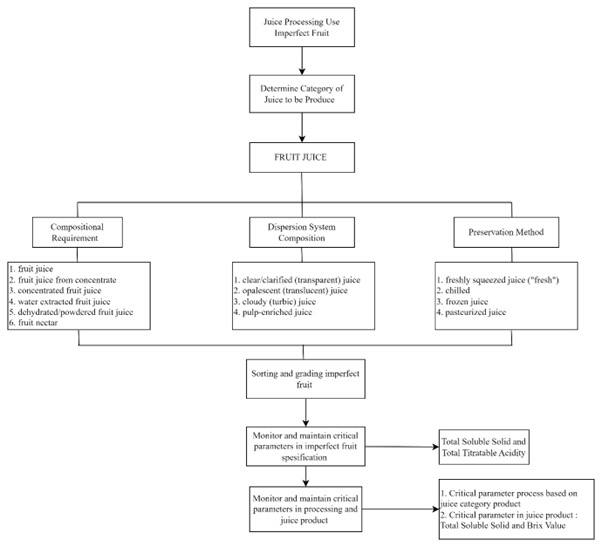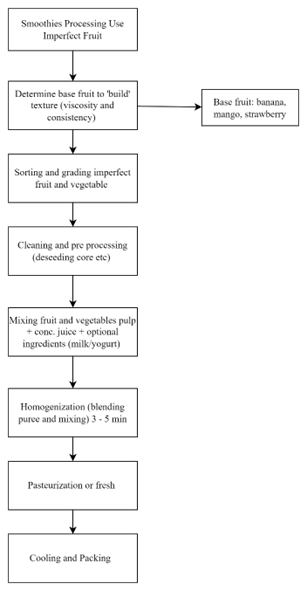How to use Imperfect Fruits and Vegetables to Produce Juice and Smoothies
What are imperfect fruits and vegetables?
Imperfect produce refers to food that is non-uniform in shape, color, or texture but is free of any damage that might pose a health threat. Imperfect products also refer to fruits and vegetables, which drive consumers to devalue and are less inclined to purchase aesthetically imperfect, deformed, scarred, and/or discolored. Consumer acceptance of imperfect fruits and vegetables will indirectly impact food waste and loss. Producers, retailers, and households discharge large amounts of perfectly edible food because it is considered suboptimal either through its physical appearance, ‘ugly’ shape, color, and texture, or by other product characteristics (tactility, smell, etc.).

Figure 1. Imperfect Fruit and Vegetable
Awareness and knowledge about imperfect fruits and vegetables will be the key factors to shift consumer preference and acceptance when they buy fruits and vegetables. The standardization quality of fruit and vegetables must be clear for imperfect terms of the shape, color, and texture of fruits and vegetables. Evaluation and validation of the quality limit of fruit and vegetables, till it is safe to consume by customers, must be implemented in each stage of the food supply chain to avoid the obscurity of standard specifications. Application of standard specification of imperfect food and vegetables, followed by increasing awareness, knowledge, and attitudes of the food waste issue and reducing food waste, is a perfect strategy to give value-added imperfect food and vegetables as an ingredient for food products, especially juice and smoothies.
How do you use imperfect fruits and vegetables as ingredients?
The transformation of imperfect fruits and vegetables into new products such as juice and smoothies is an effective and efficient strategy to change customers’ perspectives and preferences to buy different category products using imperfect fruits and vegetables as ingredients. Consumers are willing to buy physically processed products (juice and smoothies) regardless of whether they have it produced using perfect or imperfect fruit and vegetables. Processing imperfect produce with appropriate standard specifications and methods is needed to get optimum quality of juice and smoothies.
A scoring and grading system can define the standard specification of imperfect fruits and vegetables. This system determines the level of tolerance for each type of defect, such as cuts, bruises, disease, low-temperature injury, and physiological disorders. The level of tolerance will be used as a reference for critical limits in the quality control system. Implementation of a quality control system is needed at the retailer distribution center that involves statistical sampling protocols and quantitative measures of quality attributes, including fruit firmness, temperature, juice total soluble solids (TSS) content, and juice total titratable acidity.
How do you use imperfect fruits and vegetables in juice products?
Codex Alimentarius Commission defines fruit juice as the unfermented but fermentable – liquid obtained from the edible part of the sound, appropriately mature and fresh fruit or fruit maintained in sound condition by suitable means, including postharvest surface treatments applied by the applicable provisions of the Codex General Standard” (CODEX STAN 247- 2005). Vegetable juice is defined (FAO, 1992) as: “the liquid unfermented but fermentable product or lactic acid fermented product intended for direct consumption obtained from the edible part of one or more sound vegetables and preserved exclusively by physical means. Fruit and vegetable juice processing using imperfect fruit and vegetables can be challenging due to the implementation of different quality standards compared with perfect fruit and vegetables. This challenge can be overcome by defining the category of juice that we want to produce and then looking for characteristic imperfect fruits and vegetables that are suitable to the specification of the final juice product. The step-by-step application of imperfect fruit and vegetables as ingredients to produce juice can be seen in Figure 2.

Figure 1. Application of imperfect fruit and vegetables to produce juice
How do you use imperfect fruits and vegetables in smoothie products?
Smoothies refer to blended drinks that are usually semi-liquid in viscosity, made with various combinations of fruit and vegetables, and include fruit, fruit juice, and additional ingredients like yogurt, milk, or honey. Following the changing market trends, smoothie development answers the needs of consumers for healthy drinks, which provide benefits to prevent chronic diseases such as obesity, diabetes, and cardiovascular disease. Smoothies generally consist of high levels of nutrients such as antioxidants, fibers, and vitamins with low energy content due to a combination of more than one fruit and vegetable. Moreover, the addition of superfoods like spirulina, rosella, moringa oleifera, etc gives functional added value usage of imperfect fruit and vegetables in smoothie products. Figure 3 shows the step-by-step application of imperfect food and vegetables as ingredients to produce smoothies.

Figure 2. Application of imperfect fruit and vegetables to produce smoothies
References:
De Hooge, I. E., Oostindjer, M., Aschemann-Witzel, J., Normann, A., Loose, S. M., and Almli, V. L. 2017. This apple is too ugly for me!: Consumer preferences for suboptimal food products in the supermarket and at home. Food Quality and Preference, 56, 80–92.
Loebnitz, N., Schuitema, G., and Grunert, K. G. 2015. Who buys oddly shaped food and why? Impacts of food shape abnormality and organic labeling on purchase intentions. Psychology and Marketing, 32(4), 408–421.
Rajauria, G., and Tiwari, B. K. 2018. Fruit juices: Extraction, composition, quality, and analysis. Academic Press.
Lagerkvist, C. J., Edenbrandt, A. K., Bolos, L. A., and Nayga, R. M. 2023. Consumer acceptance of aesthetically imperfect vegetables – the role of information framing and personal values: Evidence from the United States. Food Quality and Preference, 104, 104737.
Barone, A. M., Donato, C., and Romani, S. 2021. Physically processing imperfect produce: The impact of prototypicality. Journal of Consumer Behaviour, 20(6), 1547–1561.
Goyal, M.R and Ahmad, F. 2023. Quality Control in Fruit and Vegetable Processing: Method and Strategies. CRC Press, USA.
FAO (1992): Food and nutrition at the turn of the millennium. Information Division, FAO of the UN. Rome, Italy 2p
“CODEX STAN. 247, 2005” General standard for fruit juices and nectars. (by APA standard)
Further reading
Quality Standardization of Fresh Fruit and Vegetables to Reduce Food Waste and Loss










































































